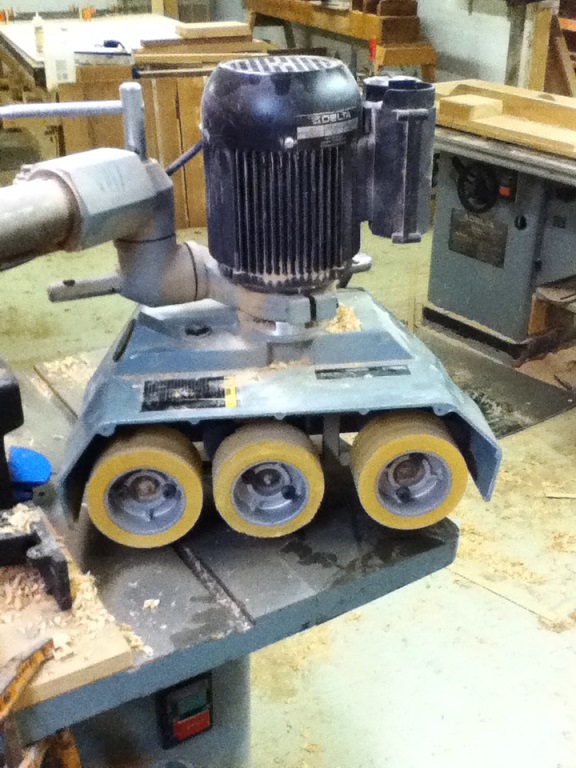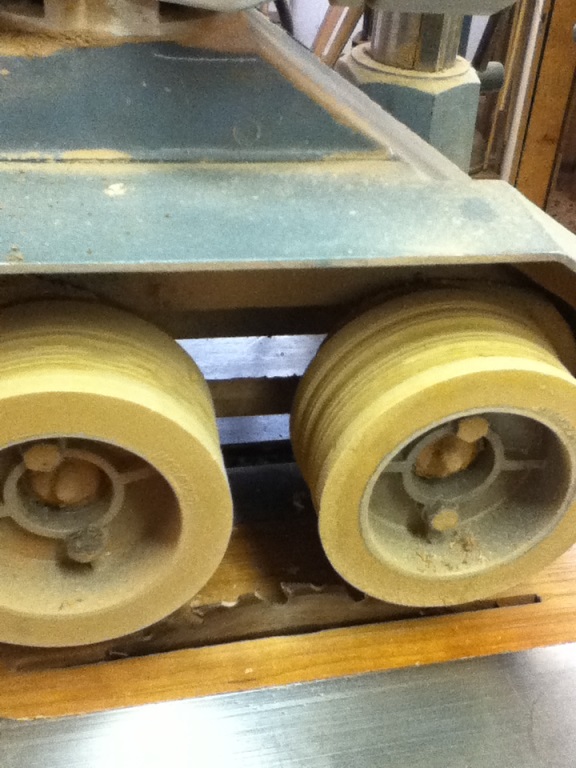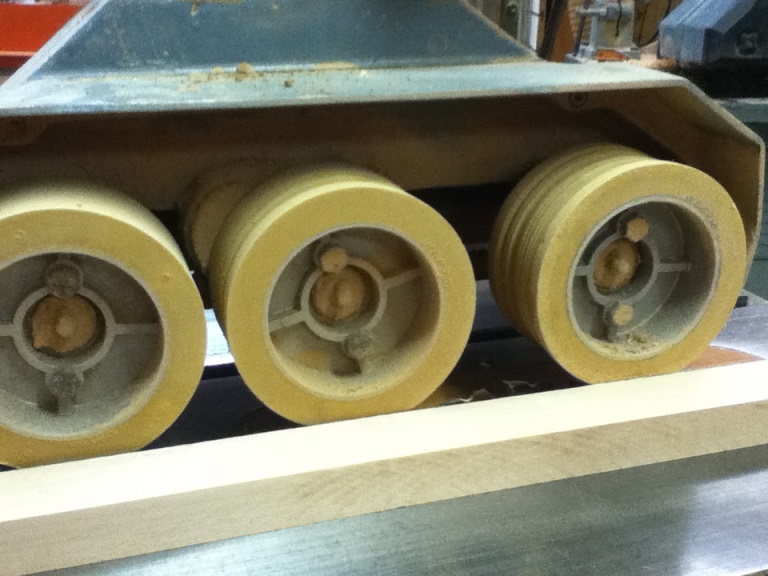A stock feeder, also known as a power feeder, is basically a woodworking machine mounted to another woodworking machine, with the purpose of pulling stock through a saw or past a cutter. They are available in motor sizes ranging from 1/4 to 1 horsepower with a two-speed reversible motor and with a capacity for changing the feed speed through the gear box for a total of four forward and four speeds in reverse. They generally come with three or four rubber coated wheels for feeding the stock. There are also versions that use belts to do the feeding.
 This shot shows the feeder from the side with the “tires” that pull the material through the machine.
This shot shows the feeder from the side with the “tires” that pull the material through the machine.
Advantages of stock feeders
There are many advantages to using stock feeders in the shop. In my opinion, their No. 1 advantage is safety. Because they are located above or in front of saw blades and cutters, they keep the user’s hands safely out of harm’s way. Also, because they are pulling and holding the wood to the machine, they virtually eliminate one of the No. 1 causes of injury in the workshop, which is kickback, when material is shot backwards out of a machine.
A second advantage of stock feeders is the quality of cut obtained when ripping at the table saw. Because the feeder is running the material past the saw at a consistent rate of speed, the resulting cut is uniform in the number of cuts per inch with no starts or stops common when stock is fed by hand. Also, stock feeders allow very narrow stock to be run at the table saw, which is often difficult, awkward and dangerous to do when hand feeding.
One of my favorite advantages of having a stock feeder is the ability to climb cut on the shaper. To the uninitiated, this is when stock is fed into a shaper in the same direction as the rotation of the cutter. (This can also be done at the router table.) This method of feeding virtually eliminates tear out, and once again, because of the consistent rate of feed, the quality of the cut is superior to one that has been hand fed. This method of feeding can only be done using a power feeder and is dangerous and not recommended when feeding by hand.
Another advantage of the stock feeder is that it gives the woodworker the ability to run slightly bowed stock through a saw or over a shaper as the pressure of the feeder will hold the board down.
Some may question having a feeder in a one-person shop, but that is another area where they provide an advantage when a person working by themselves can feed long boards that would otherwise be to difficult to handle by one person.
There are many more advantages to having feeders in the shop. Another of my favorites is using them to cut coves on the table saw, which is a subject I plan to cover in depth in another post.
Tips on using stock feeders
Learning to adjust a stock feeder can at first be rather confusing. There are a number of ways they can be turned in relation to the machine, which is one reason why they are so versatile.
The basics are as follows:
- With a three tire setup, two of the tires are generally spaced slightly further apart. The feeder should be adjusted so that the saw blade or cutter is centered in this space. The height of the feeder tires should be adjusted so that they set approximately 1/4 inch below the top of the stock being fed.
- The feeder should also be adjusted so that it is canted slightly closer to the out feed side of the fence, which will facilitate in keeping the stock firmly against the fence.
- Lastly, the speed of the feeder should be adjusted to match the work to be performed. For example, sawing stock 2 inches thick on the table saw will probably require a slower feed rate than would sawing 1-inch thick stock. Also, the quality of the cut desired can have a bearing on the feed rate. When running moldings on the shaper, I will often slow the feed rate down for the last cut, which results in a cleaner cut due to the higher number of cuts per inch.

This shot shows the feeder adjusted so that the tires span the saw blade.
 This shot shows how the feeder height should be adjusted in relation to the material.
This shot shows how the feeder height should be adjusted in relation to the material.
As I have mentioned earlier, the stock feeder is a very versatile machine, and once you have one, it is just left to your imagination as to the many ways they can be utilized in the shop.

Share tips, start a discussion or ask one of our experts or other students a question.
No Responses to “Why Should You Use a Stock Feeder?”